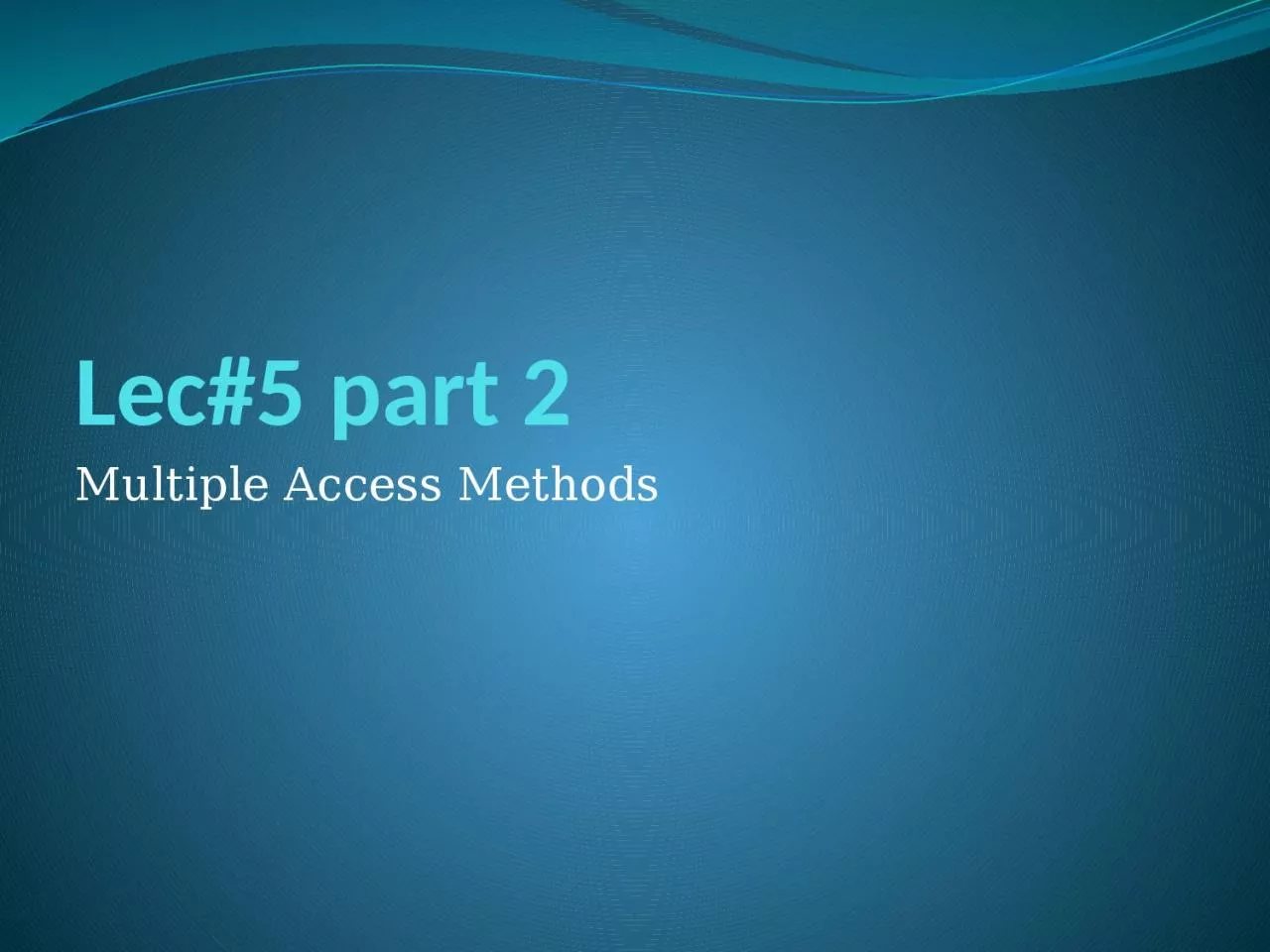

Multiple Access Methods Multiple Access Methods When nodes or stations are connected and use a common link cable or air called a multipoint or broadcast link we need a multipleaccess protocol to coordinate access to the link ID: 1031042
Download Presentation The PPT/PDF document "Lec#5 part 2 Multiple Access Methods" is the property of its rightful owner. Permission is granted to download and print the materials on this web site for personal, non-commercial use only, and to display it on your personal computer provided you do not modify the materials and that you retain all copyright notices contained in the materials. By downloading content from our website, you accept the terms of this agreement.
1. Lec#5 part 2Multiple Access Methods
2. Multiple Access Methods
3. Multiple Access MethodsWhen nodes or stations are connected and use a common link (cable or air) , called a multipoint or broadcast link, we need a multiple-access protocol to coordinate access to the link.It is a set of rules that defines how a stations puts data onto the link and takes data from the link .
4. Multiple Access MethodsMany formal protocols have been devised to handle access to a shared links. We categorize them into three groups.
5. 1 CONTROLLED ACCESSIn controlled access, the stations consult one another to find which station has the right to send. A station cannot send unless it has been authorized by other stations.Two methods:Polling Access MethodToken Passing Access Method
6. 1.1 Polling Access MethodIn this access method, one station is designated as the primary device and the others are secondary stations.All access to the network is controlled by the primary station.The primary queries (polls) each of the secondary stations in turn, if it has information to be transmitted. Only when it is polled does the secondary have access to the communication channel.
7. 1.1 Polling Access Method Select Poll
8. 1.2 Token-Passing Access MethodIn this access method, a special type of packet, called a token, circulates around a cable ring from station to station . When any station on the ring needs to send data across the network, it must wait for a free token. When a free token is detected, the station will take control of it if the station has data to send.
9. 2 Random Access MethodsIn random access or contention methods, no station is superior to another station and none is assigned the control over another (i.e. each station has the right to the medium without being controlled by any other station). It is named contention method because stations on the network contend, or compete, for an opportunity to send data.Methods:Carrier-Sense Multiple Access With Collision Detection Carrier-Sense Multiple Access With Collision Avoidance
10. Carrier-Sense Multiple AccessIn this way of methods, each station first listen to the cable (or check the state of the cable ) before sending.When the station "senses" that the cable is free ( that there is no traffic on the cable) it can send a frame. Once the station has transmitted frame on the cable, no other station can transmit data until the original data has reached its destination and the cable is free again.
11. CollisionsEven though each station listens for network traffic before it attempts to transmit, an access conflict -collision- will happen if more than one station tries to send at the same time.When a collision happened, the frames will be either destroyed or modifiedThe collisions occur because it takes time for signals to propagate through the link. Two specialized methods of collision management have been developed to improve performance: Collision Detection (CD) and Collision Avoidance (CA).
12.
13. 2.1 Carrier-Sense Multiple Access With Collision Detection The carrier-sense multiple access with collision detection (CSMA/CD) adds a procedure to handle a collision. In this method, a station monitors the medium after it sends a frame to see if the transmission was successful. If so, the station is finished. If, however, there is a collision, the frame is sent again.In the case of collision, the two stations involved stop transmitting for a random period of time and then attempt to retransmit. Each station determines its own waiting period; this reduces the chance that the computers will once again transmit simultaneously.
14. 2.2 Carrier-Sense Multiple Access With Collision Avoidance The Carrier-Sense Multiple Access With Collision Avoidance (CSMA/CA) differs from the previous method in that there is no collision.Each station signals its intent to transmit before it actually transmits data.
15. Differences1.CSMA CD takes effect after a collision while CSMA CA takes effect before a collision.2.CSMA CA reduces the possibility of a collision while CSMA CD only minimizes the recovery time.3.CSMA CD is typically used in wired networks while CSMA CA is used in wireless networks.
16. 3 CHANNELIZATIONChannelization is a multiple-access method in which the available bandwidth of a link is shared in time, frequency, or through code, between different stations.Used for wireless communications.Methods:Frequency division Multiple AccessTime division Multiple AccessCode division Multiple Access
17. 3.1 Frequency-Division Multiple AccessIn frequency-division multiple access (FDMA), the available bandwidth is divided into frequency bands.Each station is allocated a band to send its data. In other words, each band is reserved for a specific station, and it belongs to the station all the time.
18. 3.2 Time-division Multiple AccessIn time-division multiple access (TDMA), the stations share the bandwidth of the channel in time. Each station is allocated a time slot during which it can send data. Each station transmits its data in is assigned time slot.
19. 3.3 Code-Division Multiple AccessIn the code-division multiple access (CDMA), each station assigned a code that used to send its data. Several transmitters can send information simultaneously over a single communication channel.However, with CDMA, unique digital codes are used to separate each signal.